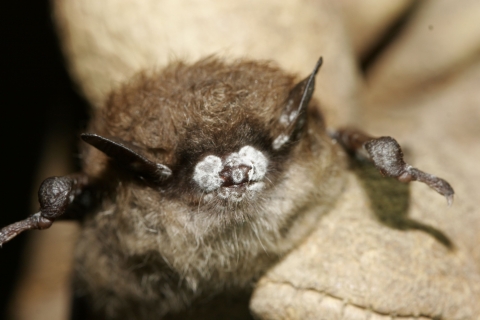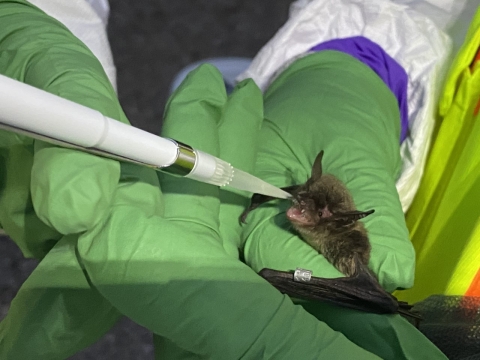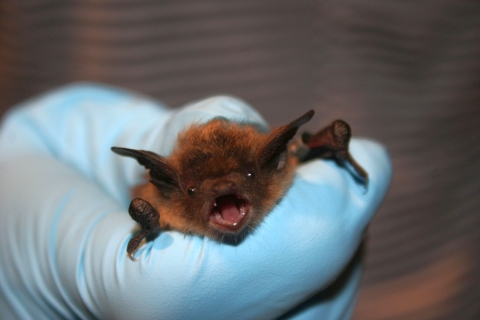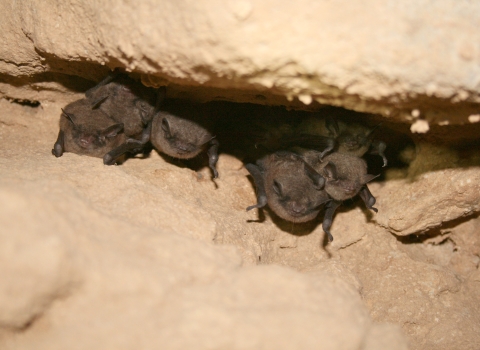Bats, our winged friends so often associated with all things creepy and spooky, are some of the most misunderstood and underappreciated members of the animal kingdom. Bats come in all shapes and sizes — some as small as an inch, and some with wingspans larger than five feet — they dine on an array of bugs and fruits, and are key pollinators for a number of our favorite foods and spices. But, in spite of this, bats still can’t seem to shake the notoriety that comes with being a creature of the night.
Vampires, Bats and Vampire Bats
When it comes to things that go bump in the night, one legend is found in almost every culture since the beginning of recorded history: vampires. These diabolical creatures of the night, with their fearsome fangs and bat-like personas, provide the perfect inspiration for campfire stories and costumes.
Vampires seem to be one of humanity’s universal myths, dating all the way back to Ancient Egypt, Mesopotamia, and appearing as the Préta or BrahmarākŞhasa in India, Mandurugo in the Philippines, Adze or Sasabonsam in West Africa, Camazotz in Ancient Maya, Guajona in Spain and the legendary Nosferatu in Ancient Romania, precursor to the Prince of Vampires himself, Count Dracula.
One common thread that connects almost all vampire legends is the age-old scapegoat: the unlucky bats that somehow keep getting associated with their beastly brethren. Bats have an impressive range of fascinating abilities and habits that border on the supernatural, making it all too easy to use them as inspiration for dark and devilish fiends. But bats are one of nature’s most misunderstood creatures — and they are also critical members of our planet’s ecosystem and our food chain (and, they can be downright adorable).
Among the 1,300+ species of bats worldwide, only three claim the title of vampire bat: the common vampire bat (Desmodus rotundus), the white-winged vampire bat (Diaemus youngi) and the hairy-legged vampire bat (Diphylla ecaudata).
These bats are named after the Transylvanian legend because they feed entirely on blood. They even have heat sensors on their noses that help them find warm blood in their victim’s skin. Although the common vampire bat feeds on mammals (yes, sometimes humans), the hairy-legged and white-winged vampire bats prefer bird blood. Scientists have also found that vampire bats can recognize their prey by the sound of their breathing, allowing them to return for second helpings (Dracula would be so proud).
Here is where it gets interesting for conspiracy theorists: Vampires have existed in folklore for thousands of years in cultures around the world, but vampire bats were only known to the people of Central and South America. After Europeans arrived on the shores of the New World, the stories about winged, blood-sucking bats spread around the world — long after the legend of the undead was born. So, the vampire bats were actually named after their human doppelgangers, not the other way around.
Most bats don’t feed on blood — they eat fruit or insects — but they are nocturnal, sleep upside down, and many can see in total darkness using echolocation, which isn’t a far stretch from many vampire legends.
In fact, some bats are so good at “seeing” with their ears that scientists are studying their echolocation abilities to develop a new class of assistive devices for people with vision impairments.
How We Benefit From Bats
Although they might be cast in the role of creepy creatures of the night, bats are actually unsung superheroes vital to the health of our environment and our economy. By providing a number of services from pollination to seed dispersal (through their poop!), many ecosystems and agricultural systems wouldn’t survive without bats.
There’s no denying that tequila would be sorely missed by many if there were no bats to pollinate agave plants. Without bats, you could also say goodbye to your morning smoothies and fruit salads because bats are key pollinators for mangoes, peaches, guava and bananas. Cloves, a popular spice around the world, used in savory and sweet dishes alike — including the ever-popular pumpkin spice — are also pollinated by bats, so next time you find yourself sipping on a PSL or crafting a killer cocktail, be sure to toast the bats that made it happen.
Our winged friends are also the midwatch vanguards of pest control, saving crops from cucumber beetles, stink bugs, leafhoppers and June bugs. In fact, bats eat so many insects that studies estimate their economic impact to be more than $1 billion per year in avoided crop damage and pesticide costs in the U.S. corn industry alone. Across all agricultural production, consumption of insect pests by bats results in a savings of at least $3.7 billion per year. This also means fewer insects that carry diseases like malaria and West Nile virus. And since bats eat so many insects — many of which have shiny exoskeletons — some bats have guano that sparkles. So, maybe your favorite tween vampire movie wasn’t so far off, after all?
Bats are real wing-mates for human health, too. Scientists have been studying bats to understand their exceptional tolerance to DNA damage, parasites and viruses, in the hopes of finding a way to improve human resilience against RNA viruses like Ebola and coronaviruses, parasites like malaria and DNA damage from cancers. Scientists have also been studying the saliva of bats in an effort to develop a medication for stroke patients.
Oh, and you’ll never guess what they named it.
A drug, named after a vampire, derived from a vampire bat, which was named after vampires.
Threats to Bats
As fun as it is to deal in the macabre when it comes to scary stories about bats, these amazing animals need our help. Bats are declining across the globe. Disease, habitat loss and human activity, including disruption during hibernation, all play a major role in the decline of bat populations worldwide.
In North America, a fungal disease called white-nose syndrome has claimed the lives of more than 6 million bats since it was first documented in 2006. White-nose syndrome has since spread at alarming rates, making it one of the deadliest wildlife diseases on the continent.
The tell-tale fungus that causes white-nose syndrome is primarily spread from bat to bat, but it can also be spread from the environment to bats, as the fungus can survive for many years in the soil in caves and mines where bats hibernate. Scientists have demonstrated that it may be possible for humans to inadvertently carry fungal spores on their clothes or equipment, which can facilitate its spread to new areas.
What We’re Doing to Help Bats
The U.S. Fish and Wildlife Service (Service) is working with our partners to protect bats, research treatment and management options to halt the spread of white-nose syndrome, and raise awareness about how incredible and vulnerable bats are.
Over the last decade, the Service has awarded more than $35 million in grants to researchers and state wildlife agencies to contain the spread of white-nose syndrome, improve our understanding of this fungus and its impacts, and develop tools to increase the survival of affected bat species. The Service and others are also working to minimize bat mortality from wind turbines and many federal and state natural resource agencies and conservation organizations have protected caves and mines important for cave-dwelling bats. Learn more about what we are doing to prevent and treat white-nose syndrome.
How You Can Help
- Talk about bats. Share what you’ve learned about the importance of bats. We can all benefit from a greater understanding of the world around us. While it is always smart to be aware of the risk of rabies infection from bats, understanding bats will go a long way toward protecting these amazing creatures and ourselves.
- Do not disturb. Even slight disturbances can cause bats to leave their roosts and force them to use valuable energy reserves needed to survive hibernation. Do your part to protect them by respecting all cave closures and advisories, avoiding caves with hibernating bats and following national decontamination procedures before and after visiting caves and mines.
- Don’t touch bats — leave that to the professionals. In addition to protecting bats from people, we should keep our distance for our own safety, and to prevent the spread of diseases from wildlife to people. Bats should never be handled by untrained or unvaccinated persons.
- Turn off the lights. Light pollution can disrupt or deter bats. Providing a dark environment can help improve conditions for bats.
- Reduce pesticide use. Consider using natural pest control remedies, such as soapy water, beer or garlic. Pesticides can affect the food and water supply for bats.
- Plant a garden. Creating a garden will help attract insects that help pollinate plants and feed bats, contributing to the circle of life.
- Build a bat house or bat box. These tiny structures are a win-win for bats and humans. They can hold up to 100 bats, providing them with much-needed roosts while the bats keep the pests at bay around your house.
- More ways to be friends to bats.
So, the next time you’re in line for your latte or toasting happy hour with friends, send some love to a bat and help us ensure that we can continue to benefit from the services they provide that make our lives better — and a little more delicious.










